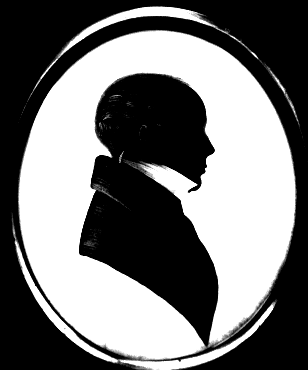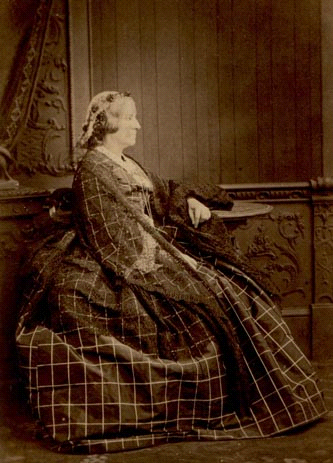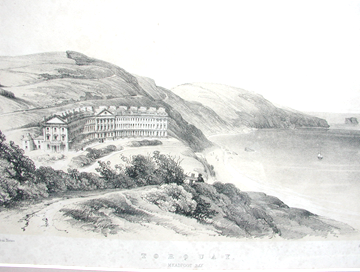Navigation: Alers Hankey > Miss Alers > William Alers >
1803 - 1872
Eldest surviving son of William Alers Hankey and Mary nee Martin, John was born on 23 Jan 1803 at Fenchurch Street, and was baptised on 11 Apr 1803 at the Independent chapel at Bull Lane, Stepney. The family moved in 1810 to Hackney, and it was there that he spent much of his youth. He was educated at Mill Hill School, as were his four brothers.

John Alers Hankey
John Alers Hankey entered the business of Hankey & Co on 27 Jan 1820, four days after his seventeenth birthday. He became a partner in about 1831, but was not, as has been claimed, a Governor of the Bank of England. While a junior partner, he was required to live at the bank, as was then the custom of the family. ‘There was gt anxiety still about opening by a partner & also living over the Banking House. Bankers responsibilities were considered to be weighty in those days. A Confidential Clerk at last favored the sleeping of partners away from the City.’ John’s elder son John Alers Hankey Jr, ‘had many tales to tell of the old place and old customs and told how the walls of the Bank were lined with racks of Muskets to protect the place from the rioters, and how he lost his fowling piece by putting it in the rack when returning tired from shooting and lost it.’
John was married on 16 Sep 1829 at Hackney, St John, to Sarah Andrews Jameson, the beautiful second daughter of William Jameson of Clapton and his wife Sarah nee Kingsbury. Augustus Hankey wrote on the following day that ‘Master John was married yesterday, they set out for the lakes in a Briska which might be covered in, and were to sleep at Woburn near the Duke of Bedfords. It is a good town. The ceremony was performed much to the satisfaction of all parties no crying no levity no affectation and the folk signed with steady hands. The Relations of all sides were present. From all I can hear Jack has drawn a prize. He has got a most amiable woman in every respect for his wife, one that will do her duty, and comfort him in foul as well as in fine weather, a good person, good understanding, and all the accomplishments that can be necessary. ‘.. She also has all the information that can make her society desirable and pleasant. ‘.. The mother who is a most excellent housewife has taught her everything she should know in that department ‘..
Both of Sarah Jameson’s grandfathers were Dissenting Ministers, as was the father of both her grandmothers (who were half sisters), so it is not surprising that she herself was ‘exceedingly pious’. But it seems he did not attend Church at Stepney after his marriage, and shortly afterwards became a member of the Established Church. John, like his father, wife and others of his immediate family, was undoubtedly deeply religious, as were many of his children.
John and Sarah had eleven children; of these, five sons and two daughters survived, the daughters being the youngest:
1830-1900 |
||
1831-1902 |
||
1833-1910 |
d. unm. see below |
|
Emily |
1835-1838 |
d. inf. |
1836-1917 |
||
1838-1905 |
||
1840-1919 |
||
Sarah Maria |
1841-1919 |
d. unm. |
Samuel |
1845-1845 |
d. inf. |
Emily Mary (Em) |
1851-1897 |
d. unm. |
Frances |
1852-1860 |
d. inf. |
John Alers Hankey would never, like his father, have been a Mr Papa to his children. True, when he found his sons playing cards he put them at the back of the fire; and his daughters were never permitted to waltz. But his beautiful wife, whom he adored and spoiled, would never have tolerated a Mr Papa as far as she herself was concerned. Not a strong woman, Sarah had inherited a tendency to ‘nerves’ from her mother - and most unfortunately a tradition of giving way to them. It was not uncommon for her to be summonsed to her mother’s death bed and on hastening there, to be told that the lady was out driving!
What wonder if Sarah herself was idiosynchratic. With a fashionable and exceedingly pious physician in attendance, she succeeded in getting what she needed - or wanted - every time, which was ‘constant change’. And what she wanted, she wanted terribly badly, and there was something eloquent and so compelling in the expression and the large and beautiful eyes, that they would probably have won the day even if the physician had not made her desires his orders. Not content with frequent trips to Brighton, Eastbourne and Scotland, she would frequently discover that the soil under the family residence was poisonous to her; and the whole lumbering Victorian household, with its retinues of men- and maid-servants, would have to be transferred elsewhere.

Mrs John Alers Hankey
John’s first four children were born at 7 Fenchurch Street, but by 1836 he had moved with his growing family to a house with one acre at Balham Hill.
After this, soils all over London were tried and condemned in turn. The family lived for a time at Lloyd House, Grotes Buildings, Blackheath (1843, 1851); then at 98 Westbourne Terrace (1852, 1858); 10 Park Crescent, Regents Park (1865); and Kensington Palace Gardens (1872). In 1861 they were staying at the Oatlands Park Hotel in Weybridge. The environs of London were experimented with; Sheen [or Egham] Lodge, Richmond was one of the temporary residences (1870), and they even went as far as Dorking. In 1871 she was staying at Richmond with her first cousin Anne Terrell. But no place suited Sarah for long.
She had the keenest enjoyment for foreign travel. Switzerland she often visited, and Rome fascinated her. The boredom of settling down permanently she could not abide. In vain her husband sighed that he could never lay down port, and her growing daughters found promising friendships with neighbours nipped in the bud all too often thanks to this constant family uprooting - but all that was possible must be done for the invalid.
John was only 68 when he died on 15 Jan 1872 at Kensington Palace Gardens, leaving an estate under £140,000.
He had purchased a plot in Bunhill Fields in about 1833, but having become a member of the Church of England, it was never used and he was buried on 19 Jan 1872 at Norwood Cemetery (No. 37191).
Sarah lived for another thirteen years, and during her long widowhood she travelled frequently.
‘Always in considerable luxury and surrounded by an admiring circle - a devoted daughter, a companion, maid and courier, and sometimes a male admirer - an artist perhaps, for Sarah was passionately interested in art, music and all beauty. She played and sang herself, and did beautiful needlework. She was magnetic to the last. Obviously she could not be troubled much with the usual call-paying and party-giving life of London. She had no social aspirations but she enjoyed good talk. There was, of course, a great gathering of pious folk about her.’
‘Mr Harris, who was the undoing of Lawrence Oliphant [see DNB], strayed into her circle but disappeared again. A certain shrewdness would probably have prevented her from accepting his teaching in toto.’
Sarah died aged 78 on 26 Dec 1885 at Queen Anne’s Mansions, Westminster, a block of flats built by her son Henry.
She was buried on 1 Jan 1886 at Norwood Cemetery (No. 66440), the officiating minister being her first cousin Rev Thomas Luck Kingsbury, Prebendary of Salisbury.

Meadfoot House, Torquay (left of terrace)